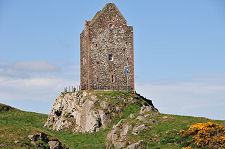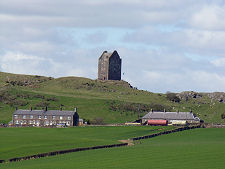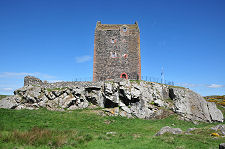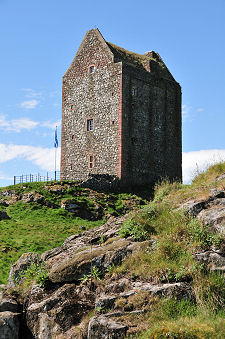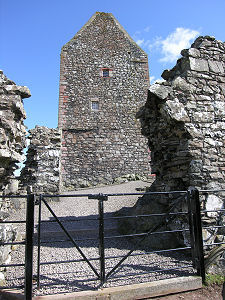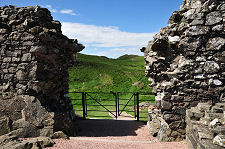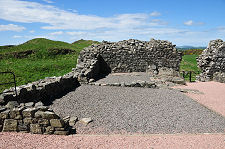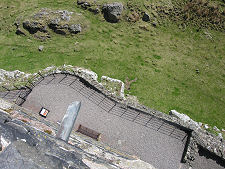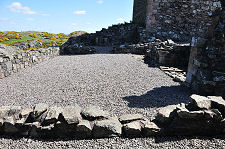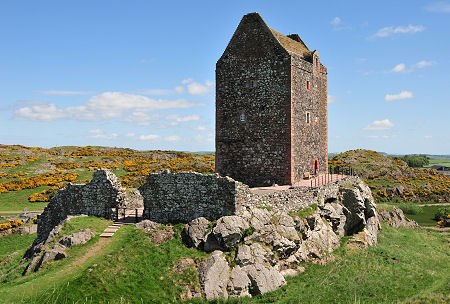 Smailholm Tower from the South |
As the crow flies, Smailholm Tower lies almost exactly mid way between Melrose and Kelso. Access is either from the village of Smailholm, whose fine Norman church is worth a visit, or from the B6404, four miles north-east of St Boswells. A minor road leads you through the farmstead of Sandyknowe and along a track past an old millpond to the parking area for the tower. From here you have a choice of steep or less steep grassy paths for the final hundred yards.
The landscape that immediately surrounds Smailholm Tower is remarkable. Though the tower lies less than two miles north of the River Tweed, the surrounding chaos of rocky outcrops would actually be quite at home at the opposite end of the country, in north-west Sutherland.
It is very easy to see why this site suggested itself for the construction of a defensive tower house. For five hundred years, the border between England and Scotland was witness to repeated wars both large and small, and even in nominally peaceful times, cross border banditry was the norm rather than the exception.
Smailholm Tower stands on a rocky crag that is just large enough to support the tower and the courtyards to its north-east and south-west. These were surrounded by a tall barmkin wall, now standing to anything like its original height only at the south-west end. (Continues below image...)
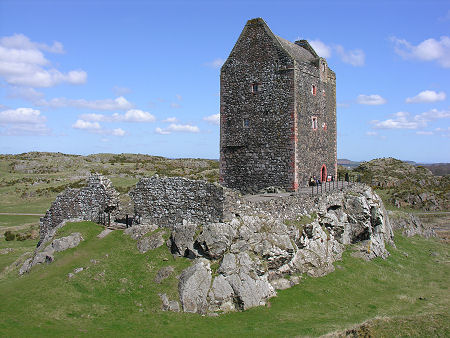 The Tower from the South Before the Grass Roof was Installed |
The tower was once the centre of a thriving settlement. The west courtyard was originally home to a hall and a kitchen, though in the 1650s the hall was replaced by a house. Outside the barmkin wall would have once stood cottages, stables and cattle enclosures, and traces of some of them can still be seen on the ground. There would also have been a mill, on the site now occupied by Sandyknowe Farm to the south-east of the tower. The millpond still exists.
The only building now standing is the tower itself. This is a fairly typical tower house with five storeys, each of one major room, piled on top of one another. The building has stone vaulting between the second and third floors, and at roof level: indeed, today's roof is in effect as a vaulted ceiling, which has been given an outer cladding of living grass.
The ground floor is now the Historic Environment Scotland reception and shop, while the mezzanine floor, originally used for storage, has a range of visitor displays and an excellent cut-away model of the tower. The upper three floors originally provided accommodation for the laird and his family.
The main focus of castle life would have been the hall on what is confusingly called the first floor. Above this would have been a main bedroom, with one or more further bedrooms in the top floor under the roof.
Doors from the upper floor give access to two wall-walks, one on the north-west side of the tower, the other on the south-east side. These would have formed an important part of the tower's defences when under attack. The location gives staggering views from the wall-walks. Other signs that the tower was not just for show include a gun loop allowing the west courtyard and main gate to be covered, and another above the main door to the castle.
And Smailholm Tower certainly saw its share of action. It was built by the Pringle family in about 1450 and remained in their hands until 1645. During the 1540s Smailholm was attacked repeatedly by English raiders, the raids only ceasing when in 1548 the Laird, John Pringle, became what was called an assured Scot. In return for a promise not to raid England or to help efforts against English raiders in Scotland, his lands would be left alone.
Cross border conflict ought to have ceased with the Union of the Crowns in 1603, but in July 1640 a group of Covenanters successfully defended the tower against an attack from Royalists during the Civil War.
In 1645 the tower was sold to Sir William Scott. The Scotts built a new house in the West Courtyard. This remained in use until the early 1700s, when the family moved to a more comfortable and less exposed house they built a few hundred yards to the east at Sandyknowe.
The most famous member of the Scott family was Sir Walter Scott. As a child he spent time here with his grandparents recovering from polio, and it was at Sandyknowe and in the shadow of Smailholm Tower that Scott came to love the ballads of the Scottish Borders.
The upper three floors of Smailholm Tower are today used as a permanent exhibition of costumed figures and beautiful tapestries that recall Scott's collections of ballards and the turbulent past of the area.
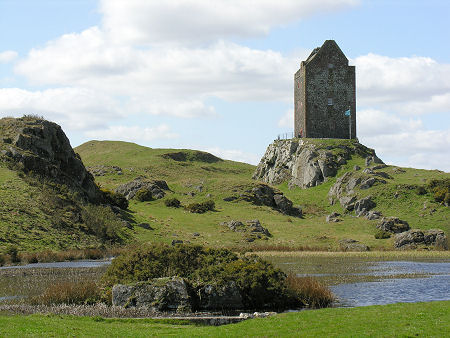 Smailholm Tower from the Millpond |

|
|
|
Visitor InformationView Location on MapSTB 5 Star Castle. Tel: 01573 460365. Post Code: TD5 7PG Grid Ref: NT 638 346 www.historicenvironment.scot HES: Tower Web Page Opening Hours Admission Accessibility What3Words Location: ///stall.perch.clash |
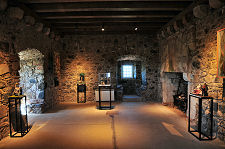 The Hall on the First Floor |
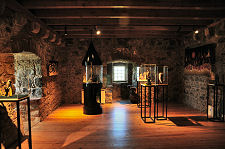 Bed Chamber on the Second Floor |
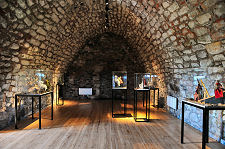 Upper Floor |
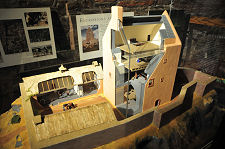 Cutaway Castle Model |
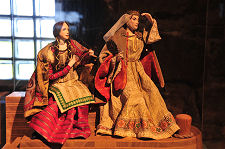 The Ladies from Sir Patrick Spens |
 One of the Tapestries on Display |
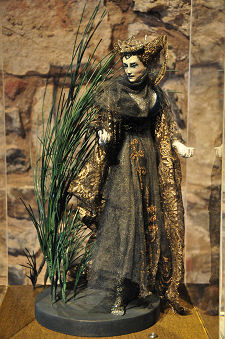 Queen of Fairies |
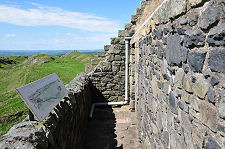 The North-West Wall Walk |
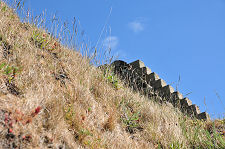 Grass Roof |
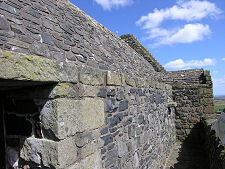 Before the Grass Roof Was Installed |
